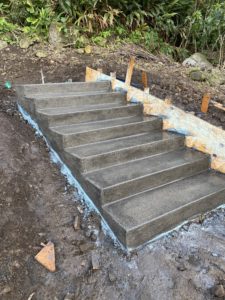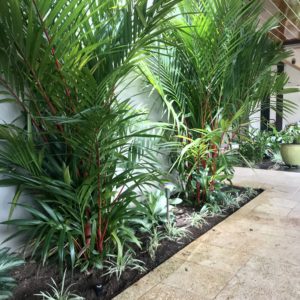Landscape Design Elements
When it comes to landscape design, hardscapes and softscapes are two important elements that work together to create a beautiful and functional outdoor space. Here are some differences and complementary factors of hardscapes and softscapes in a landscape design:
Hardscape Design:

Hardscapes refer to the non-living elements in a landscape design such as concrete, bricks, stones, pavers, and wood. They are often used to create the framework and structure of the outdoor space, such as patios, walkways, retaining walls, and fences. Hardscapes provide stability, durability, and functionality to the landscape design, and can also add a visual interest and contrast to the softscapes. Here are some examples of hardscapes and how they can be used in a project:
– Patios:
Patios are a great way to create an outdoor living space for entertaining, dining, or relaxing. They can be made of various materials such as concrete, bricks, pavers, or natural stones.
– Outdoor Shower:
Adding an outdoor shower to a landscape design can be a great way to create a relaxing and refreshing experience
– Walkways:
Walkways provide a clear and safe path for people to move around the outdoor space. They can be made of the same materials as patios or designed with a different pattern or texture to create visual interest.
– Retaining walls:
Retaining walls are used to hold back soil and create level changes in the landscape design. They can be made of poured in place concrete, concrete blocks, natural stones.
– Fences:
Fences provide privacy, security, and aesthetic appeal to the outdoor space. They can be made of wood, metal, or vinyl and come in various styles and designs.
Softscape Design:
 Softscapes refer to the living elements in a landscape design such as plants, trees, shrubs, and flowers. They are often used to soften the hard edges of hardscapes and create a natural and inviting environment. Softscapes provide color, texture, fragrance, and sound to the outdoor space, and can also attract wildlife and promote biodiversity. Here are some examples of softscapes and how they can be used in a project:
Softscapes refer to the living elements in a landscape design such as plants, trees, shrubs, and flowers. They are often used to soften the hard edges of hardscapes and create a natural and inviting environment. Softscapes provide color, texture, fragrance, and sound to the outdoor space, and can also attract wildlife and promote biodiversity. Here are some examples of softscapes and how they can be used in a project:
– Plants:
Plants are the backbone of any softscape design. They can be used to create a focal point, add color and texture, or provide privacy and shade. They can be annuals, perennials, shrubs, or trees, and come in various sizes, shapes, and colors.
– Flowers:
Flowers are a great way to add a splash of color and fragrance to the outdoor space. They can be planted in borders, containers, or hanging baskets and come in a wide range of colors and varieties.
– Trees:
Trees provide shade, shelter, and beauty to the outdoor space. They can be used as a focal point, a privacy screen, or to frame a view. They come in various sizes and shapes, and can also provide fruit or nuts.
– Shrubs:
Shrubs are versatile plants that can be used to create a hedge, a border, or a specimen plant. They come in various sizes and shapes, and can provide flowers, foliage, or berries.
Complementary factors:
Hardscapes and softscapes work together to create a balanced and harmonious landscape design. Here are some complementary factors to consider when designing a landscape:
– Scale:
The scale of the hardscapes and softscapes should be in proportion to each other and to the overall size of the outdoor space. A large patio may require larger trees or shrubs to balance the scale.
– Texture:
The texture of the hardscapes and softscapes should complement each other. For example, a smooth concrete patio may be complemented by a rough-textured stone retaining wall.
– Color:
Color plays a crucial role in landscape design, especially when it comes to hardscapes and softscapes. The choice of colors for these elements can influence the overall aesthetic of the space and create a certain mood or feeling. Here are some reasons why color choices are important when using hardscapes and softscapes in landscape design:
1. Creating a harmonious color scheme: When selecting colors for hardscapes and softscapes, it is essential to create a harmonious color scheme that ties everything together. Choosing colors that complement each other can create a cohesive look that enhances the overall aesthetic of the space.
2. Highlighting focal points: Color can be used to draw attention to certain features in the landscape design. For example, bright flowers or plants with vibrant foliage can be used to highlight a specific area or to draw the eye towards a focal point.
3. Establishing a mood: Color choices can influence the mood or feeling of the outdoor space. Warm colors such as red, orange, and yellow can create a sense of energy and excitement, while cool colors such as blue, green, and purple can create a sense of calm and relaxation.
4. Complementing the architecture: When selecting colors for hardscapes, it is important to consider the colors of the surrounding architecture. Choosing colors that complement the colors of the building or other structures can create a cohesive and unified look.
5. Reflecting personal style: Color choices in landscape design can also reflect personal style and taste. For example, a minimalist design may use a limited color palette, while a more eclectic design may incorporate a variety of colors and patterns.
Remember that hardscapes and softscapes should work together to create a cohesive and functional outdoor space. Consider how each element fits into the overall design scheme, and choose materials and plants that complement each other. With careful planning and consideration, you can create a beautiful and functional landscape design that you will enjoy for years to come.
